Imagine cruising through your neighborhood at 30 miles per hour, with the windows down and feeling the breeze. Now imagine a cyclist trying to navigate that same street, heart racing as cars pass just inches away. A new study from RMIT University suggests we can fix this mismatch without your commute becoming a slow process.
Researchers modeled all roads in Greater Melbourne and found something surprising: reducing residential speed limits from 50km/h to 30km/h reduces cyclist stress by 30% and adds only about a minute to short local car journeys. The findings come just as Victoria introduces new legislation allowing councils to propose 30km/h zones near schools and on local streets.
The stress test
The team rated the roads using a traffic stress level framework, a system that ranks streets from LTS-1, where even your grandmother would feel comfortable pedaling, to LTS-4, the kind of multi-lane arterial road that makes experienced cyclists grip the handlebars a little harder. They took into account speed limits, traffic volume, cycling infrastructure and road hierarchy using data from OpenStreetMap combined with government travel surveys and agent-based transport models.
Under current conditions, cyclists spend about 55% of their trips on low-stress roads (LTS-1 and LTS-2). If residential speeds are reduced to 30 km/h, that figure will increase to 70% for all trips and 74% for trips of less than two kilometers. More than two-thirds of the average bike ride takes place on quieter streets.
“Decreased traffic makes cycling less stressful, encouraging more people to choose cycling as a safe and viable means of transportation,” said the study’s lead author, Dr. Afshin Jafari.
The mode choice model confirmed what many cyclists already know: high-stress routes kill cyclists. The analysis showed a strong negative correlation between the likelihood of cycling and exposure to segments LTS-3 and LTS-4, those distressing stretches where the painted lines seem more like suggestions than protection.
The car question
Speed limit reductions often face obstacles for fear of gridlock and endless delays. The RMIT team anticipated this and ran simulations on 717,740 car trips to measure the real impact. The verdict? The average travel time for all car trips remained virtually unchanged. Even for trips where at least half the distance was on newly narrowed residential streets, the increase was about a minute, from about four minutes to five.
Why so minimal? Most automobile trips use residential streets only at the beginning and end, and spend most of the travel time on arterials and collectors where speed limits remain intact. The 30 kilometer per hour zones function as local speed bumps, brief decelerations that barely register on the general stopwatch.
“Most trips should use residential streets only at the beginning and end, so 30 km/h instead of 50 km/h on those short stretches makes little difference,” Jafari explained.
The simulations also revealed an unexpected advantage: daily traffic volumes on residential streets decreased slightly in the 40 and 30 km/h scenarios. Motorists naturally gravitated toward main roads, making neighborhoods quieter and safer, especially for children walking or playing.
Jafari noted that outer suburban areas, which often lack even trails, will benefit the most. Installing physical barriers on all local streets would be ideal, but requires a lot of time and capital. In contrast, reducing default speed limits can be implemented quickly and economically while longer-term infrastructure projects move forward.
The study analyzed 69,176 trips from the Victorian Integrated Travel and Activity Survey, routing each through the network in reference scenarios, 40 km/h and 30 km/h. The researchers used impedance-based algorithms to account for intersections and detours, recognizing that cyclists could accept routes up to 15-20% longer to avoid high-stress roads.
International evidence supports the findings. Research carried out in European cities shows that 30 km/h zones reduce traffic accidents by 23%, deaths by 37% and injuries by 38%. Lower speeds also reduce noise pollution by up to 40%, an advantage for urban livability.
The study did not explicitly model the resulting adoption of cycling, the next logical step. Combining the updated LTS network with the mode choice model within the agent-based simulation would allow researchers to capture both the shift from short car trips to cycling and any additional changes in car travel times generated by that shift.
Still, the message is clear: Reducing speeds on residential streets makes bicycling safer without significantly disrupting car traffic. As cities battle congestion, pollution and public health, 30km/h zones offer a practical intermediate step towards building truly bike-friendly networks.
Journal of Cycling and Micromobility Research: 10.1016/j.jcmr.2025.100085
If our reporting has informed or inspired you, please consider making a donation. Every contribution, regardless of size, allows us to continue providing accurate, engaging and trustworthy medical and scientific news. Independent journalism requires time, effort and resources; Your support ensures we can continue to uncover the stories that matter most to you.
Join us in making knowledge accessible and impactful. Thank you for being with us!
#Slowing #speed #kmh #save #life










